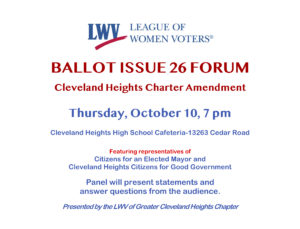Cleveland Heights from the Encyclopedia of Cleveland History
The link is here
he hamlet of CLEVELAND HEIGHTS was created in 1901, incorporated as a village in 1903, and as a city in 1921. Six miles east of downtown, it comprises 8 sq. mi., bounded on the north by EAST CLEVELAND, on the east by SOUTH EUCLID and UNIVERSITY HEIGHTS, and on the south by SHAKER HEIGHTS The Cleveland Hts. area was originally farmland in East Cleveland and South Euclid townships. The oldest surviving house, built ca. 1820, stood on Superior Rd. near Euclid Hts. Blvd. in 1994. In 1895 developers Patrick Calhoun and John Hartness Brown created the Euclid Hts. subdivision as a “garden suburb,” north of Cedar Rd. and west of Coventry Rd. Other developments followed, including Euclid Golf, at the western end of Fairmount Rd., Mayfield Hts. east of Coventry, and AMBLER HEIGHTS between Cedar and North Park Blvd. From the 1890s until well into the 20th century, the city was a “streetcar suburb.”
The village of Cleveland Hts., with 1,500 residents at incorporation, established a volunteer fire department and a public school system, which began in the old East Cleveland district school (1882) on Superior Rd. at Euclid Hts. Blvd. The high school started in 1904. The town’s first public library opened in 1911 in Coventry School. The school and library systems later consolidated with those of Univ. Hts. The longest-serving mayor was FRANK C. CAIN† (1914-45). In 1921 Cleveland Hts. established the first ZONING ordinance in Ohio and, the next year adopted the council-city manager plan of government. A Georgian Revival city hall, built in 1924, was demolished in 1986 and a new hall built at SEVERANCE TOWN CENTER. Between 1910-40 Cleveland Hts. population grew from 3,000 to 55,000. Without a central downtown, major shopping areas developed at Cedar and Lee, Fairmount and Cedar, and Mayfield and COVENTRY VILLAGE BUSINESS DISTRICT roads in the 1910s and 1920s. Despite merchant turnover and a series of fires in the Coventry area, all 3 renovated areas continued to attract patrons in the 1990s. A strong Jewish community centered at the Cedar-Taylor area in the 1920s (see JEWS & JUDAISM). Cleveland Hts. passed a bond issue in 1916 to purchase parkland and had 135 acres of public parks by 1986. FOREST HILL PARK, formerly the summer home of JOHN D. ROCKEFELLER†, was donated by John D., Jr., in 1938 and is jointly administered by the cities of Cleveland Hts. and East Cleveland. The CAIN PARK THEATER opened in 1938.
Severance Center (Severance Town Center) was built in 1963, after much controversy, on the site of the JOHN L. SEVERANCE† estate. With no INDUSTRY, 76% of the city’s land is used for residential purposes. In 1970 the population was 60,767; there were roughly equal numbers of Catholics, Protestants, and Jews. In 1960 AFRICAN AMERICANS made up less than 1% of the population, but in the 1960s and 1970s a sizable immigration of black families occurred. The Real Estate Advisory Committee to the State and the Heights Community Congress organized to facilitate integration. Due to a dispersed pattern of homebuying, Cleveland Hts. developed a high percentage of racially integrated neighborhoods. In 1980 the population fell to 56,907, including 41,192 whites, 14,061 blacks, 59 Native Americans, 674 Asians, 469 Hispanics, and 452 others. In 1990 the population declined to 54,052. By 2000, near parity in numbers of blacks and whites was reached; among the total 2000 population of 49,958 residents, whites comprised 26,229 and blacks 20,873. In 1986 there were approx. 13,000 single-family residences, nearly 2,000 duplex and multifamily dwellings, and more than 200 commercial structures. In 1986 the Cleveland Hts.-Univ. Hts. School System included 10 elementary schools, 3 junior high and 1 senior high school. By 2003, the number of elementary schools declined to 8, but the district also included Taylor Academy as an alternate high school for students academically behind schedule, BELLEFAIRE School for those with serious emotional behavioral difficulties, and the Millikin Early Childhood Center. The Cleveland Hts.-Univ. Hts. Public Library System was comprised of 3 branches and a main library. Private and parochial schools included a Baptist school, Lutheran East High School, the HEBREW ACADEMY, BEAUMONT SCHOOL, and Ruffing MONTESSORI SCHOOL.
Last Modified: 23 Mar 2003 03:06:07 PM

